Real assets fund managers respond to EU nature credits roadmap

Roadmap well intentioned, but lessons should be learnt from the UK and carbon markets
You have now reached your article limit
Already a registered user or subscriber? Sign in here
To continue reading, register free today for access
Registration also includes access to IPE
PropertyEU has now merged with IPE Real Assets
Registration will give you access to the PropertyEU archive.
If you have a PropertyEU membership find out how to get access.

Five reasons to register today
- Access IPE Real Assets articles
- Daily news alerts and updates
- Track what the world’s leading institutional investors are doing
- Learn about the latest industry research and market analysis
- Comprehensive archive of data and intelligence on investors and fund managers






